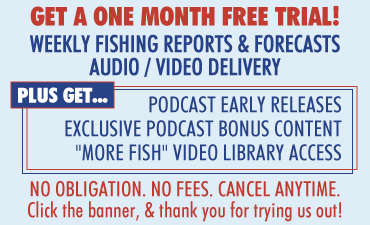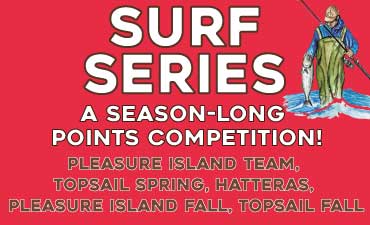Releases – July 5, 2018
Three advisory committees to the N.C. Marine Fisheries Commission will hold separate meetings in July to discuss whether concerns with the striped mullet stock warrant management changes in the fishery.
The committees’ recommendations, along with that of the N.C. Division of Marine Fisheries, will be presented to the Marine Fisheries Commission at its August 15-16 meeting in Raleigh.
Amendment 1 to the N.C. Striped Mullet Fishery Management Plan, adopted in 2015, requires the division to initiate further analysis of the striped mullet data if commercial landings fall below 1.13 million pounds or above 2.76 million pounds in any given year. In 2016, commercial landings of striped mullet fell by 15 percent from the previous year to 964,348, triggering the analysis.
A 2018 update of the state’s 2013 striped mullet stock assessment found that overfishing is not occurring, meaning the fishing mortality rate is not too high; however, it cannot be determined if the stock is overfished (whether the population is too small).
For more information about striped mullet, contact Daniel Zapf at (252) 948-3875.
The meetings are scheduled as follows:
WHO: Finfish Advisory Committee
WHAT: Discussion of striped mullet stock
WHERE: Division of Marine Fisheries’ Central District Office, 5285 Highway 70 West, Morehead City
WHEN: July 10 at 6:00 p.m.
CONTACT: Lee Paramore (252) 473-5734
WHO: Southern Regional Advisory Committee
WHAT: Discussion of striped mullet stock
WHERE: N.C. Department of Environmental Quality Regional Office, 127 Cardinal Dr. Extension, Wilmington
WHEN: July 11 at 6:00 p.m.
CONTACT: Chris Stewart (910) 796-7370
WHO: Northern Regional Advisory Committee
WHAT: Discussion of striped mullet stock
WHERE: N.C. Department of Environmental Quality Regional Office, 943 Washington Square Mall, Highway 17, Washington
WHEN: July 12 at 6:00 p.m.
CONTACT: Katy West (252) 948-3884
The N.C. Division of Marine Fisheries and the N.C. Wildlife Resources Commission are reminding the public to beware of private online sites that appear to sell state fishing licenses.
The Commission’s website is the only place online to purchase a North Carolina recreational fishing license. This is true for both inland and coastal fishing licenses.
The agencies have received complaints about at least three private websites that claim to simplify the license process for different states. Many mistakenly believe they can purchase a license through these sites.
In addition to the Commission’s website, recreational fishermen may purchase a North Carolina license through many sport shops and bait and tackle stores. Anglers can search for licensed vendors at https://www.ncalvin.org/WildlifeServiceAgentMVC.
More information about Coastal Recreational Fishing Licenses can be found on the Division of Marine Fisheries’ website at http://portal.ncdenr.org/web/mf/recreational-fishing-licenses-and-permits.
Information on coastal commercial fishing licensing can be found at http://portal.ncdenr.org/web/mf/commercial-fishing-license-information.

Tom, Caden, and Nicholas Curren, from Wilmington, with an assortment of bottomfish caught on the 2018 Intracoastal Angler’s Kids Day on the Vonda Kay.
Coastal recreational anglers can help state fisheries biologists learn more about the fish they catch by donating fish carcasses to science.
The N.C. Division of Marine Fisheries’ Carcass Collection Program has set up freezers at 12 locations along the coast where fishermen can donate fish carcasses.
The program currently accepts the carcasses of black sea bass, black drum, croaker, cobia, flounder, gray trout (weakfish), grouper, red drum, sea mullet (kingfish), sheepshead, snapper, spanish mackerel, spotted seatrout (speckled trout), striped bass, and triggerfish.
Division biologists will measure the fish, determine the sex, if possible, and remove the otoliths (ear bones) to determine the fish’s age. The information collected will be used in future stock assessments. Stock assessments rely on a variety of information, including biological data, to provide an understanding of a species’ population.
Anglers can find a map of freezer locations at http://portal.ncdenr.org/web/mf/freezers.
When cleaning the fish, anglers should leave the head and tail intact and, if possible, leave the guts in the fish. Anglers who fished on a charter boat or head boat should let the fish cleaner know the fish will be donated.
While the catch is still fresh, take the carcass to the nearest freezer location. Instructions on how to deposit the carcasses are posted on each freezer. Anglers will be asked to give information related to how and when the fish was caught. Fishermen also will be asked for their names and addresses.
For more information on Carcass Collection Program, go to http://portal.ncdenr.org/web/mf/carcass-collection, or contact Carole Willis, division sportfishing specialist, at (252) 808-8081 or carole.y.willis@ncdenr.gov.
As summer heats up, so does water activity. Visitors flock to the coast for fun and food. But warm waters also bring a potential hazard that beach-goers and shellfish eaters should know.
Vibrio bacteria, such as Vibrio vulnificus and Vibrio parahaemolyticus, are naturally occurring microscopic organisms that are not associated with water pollution. They are found in North Carolina’s coastal waters year-round, but are more abundant during the warm water months of May through October.
These bacteria can cause gastrointestinal illness and are most commonly associated with eating raw or undercooked shellfish, such as oysters, clams, or mussels. People with underlying health conditions such as liver disease, diabetes, cancer, or weakened immune systems are at a higher risk of infection and should avoid eating raw or undercooked shellfish. Symptoms usually include diarrhea, vomiting, abdominal pains, possible fever and chills, and in rare cases, sepsis, shock, and even death. If you are unsure of your risk, consult your health care provider.
Proper harvest and handling of shellfish can reduce the risk of infection through ingestion. Shellfish should only be harvested from approved waters and should be kept cool and free from cross contamination from other raw seafood products such as fish, crabs, and shrimp during transport and storage. They should be placed into refrigeration as soon as possible after harvest and held at 45 degrees Fahrenheit or cooler until ready to be cooked or consumed.
Shellfish harvested commercially require measures such as shading and a maximum time from the start of harvest until refrigeration at a certified dealer (See Proclamation SS-3-2017 and Proclamation SS-4-2017 for the specific regulations). These measures help minimize the post-harvest growth of Vibrio bacteria. Consumers should purchase shellfish only from reputable, certified dealers, retailers, grocers, markets, or restaurants. These facilities are regulated to ensure sanitation and temperature control.
Humans can also contract Vibrio infections through open wounds on the skin and contact with brackish or saltwater through a pinch from a crab, a stick from a fish spine, a prick by a shrimp, or just swimming with an open wound. People who have open wounds should either stay out of these waters or cover the wound with a waterproof bandage. If an open wound is exposed to seawater, it should be cleaned as soon as possible by taking all of the following steps in order:
- Flush the wound with sterile water, such as bottled drinking water.
- Wash the wound with soap and water.
- Flush and clean the wound with hydrogen peroxide and an iodine antiseptic solution, such as Betadine.
Symptoms of a Vibrio infection may include pain, swelling, redness, rash, ulceration, and breakdown of the skin and surrounding tissue. Anyone who experiences these symptoms following contact with brackish or saltwater should see a healthcare professional.





